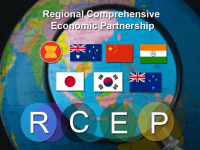 On 15 November, the 10 members of the Association of Southeast Asian Nations (ASEAN) , plus China, Japan, South Korea, Australia and New Zealand, signed the Regional Comprehensive Economic Partnership (RCEP), a free trade agreement which – once ratified – would cover nearly a third of the world’s population and account for 29% of global GDP.
On 15 November, the 10 members of the Association of Southeast Asian Nations (ASEAN) , plus China, Japan, South Korea, Australia and New Zealand, signed the Regional Comprehensive Economic Partnership (RCEP), a free trade agreement which – once ratified – would cover nearly a third of the world’s population and account for 29% of global GDP.
The full RCEP text is available @ https://rcepsec.org/legal-text/. Rules covering GIs can be found in the IP Chapter @ https://rcepsec.org/wp-content/uploads/2020/11/Chapter-11.pdf. The most relevant are the following:
- Overall, the RCEP leaves contracting party a large autonomy as to the means to protect GIs.
- Articles 11.24 (Exceptions) and 11.25 (Protection of Trademarks that Predate GIs) – both in Section C: Trademarks – seem to admit, in limited circumstances, the coexistence between an earlier trademark and a GI, as an exception to trademark rights.
- Article 11.31 (Grounds for Opposition and Cancellation, Section D: GIs) refers, as ground for opposition to GI protection, the fact that a term has become customary in common language for the relevant good in the territory of the party where protection is sought.
- Article 11.35 (Protection or Recognition of GIs under Concluded International Agreements, Section D: GIs) provides that the GIs protected in a RCEP contracting party via a concluded agreement with another party or a non-party (like the EU, which has already concluded agreement with China, Japan, South-Korea, Vietnam and Singapore) will not be affected by the treaty.
oriGIn will monitor the ratification and implementation process of the RCEP. To have the latest information on bilateral and plurilateral agreements covering GIs, please go to the dedicated page of our website.